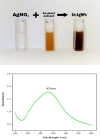Antibacterial Efficacy of Green Synthesized Silver Nanoparticles Using Salvia nubicola Extract against Ralstonia solanacearum, the Causal Agent of Vascular Wilt of Tomato
- PMID: 37663485
- PMCID: PMC10468922
- DOI: 10.1021/acsomega.3c03164
Antibacterial Efficacy of Green Synthesized Silver Nanoparticles Using Salvia nubicola Extract against Ralstonia solanacearum, the Causal Agent of Vascular Wilt of Tomato
Abstract
Ralstonia solanacearum is a phytopathogen causing bacterial wilt diseases of tomato and affecting its productivity, which leads to prominent economic losses annually. As an alternative to conventional pesticides, green synthesized nanoparticles are believed to possess strong antibacterial activities besides being cheap and ecofriendly. Here, we present the synthesis of silver nanoparticles (Sn-AgNPs) from medicinally important aqueous plant extracts of Salvia nubicola. Characterization of biologically synthesized nanoparticles was performed through UV-vis spectrophotometry, Fourier transform infrared spectroscopy (FTIR), energy-dispersive X-ray spectroscopy, X-ray diffraction, scanning electron microscopy, transmission electron microscopy (TEM), and thermogravimetric analysis. The antibacterial activity of the biosynthesized silver nanoparticles was tested against the phytopathogen R. solanacearum through in vitro experiments. Preliminary phytochemical analysis of the plant extracts revealed the presence of substantial amounts of flavonoids (57.08 mg GAE/g), phenolics (42.30 mg GAE/g), tannins, and terpenoids. The HPLC phenolic profile indicated the presence of 25 possible bioactive compounds. Results regarding green synthesized silver nanoparticles revealed the conformation of different functional groups through FTIR analysis, which could be responsible for the bioreduction and capping of Ag ions into silver NPs. TEM results revealed the spherical, crystalline shape of nanoparticles with the size in the range of 23-63 nm, which validates SEM results. Different concentrations of Sn-AgNPs (T1 (500 μg/mL) to T7 (78.1 μg/mL)) with a combination of plant extracts (PE-Sn-AgNPs) and plant extracts alone exhibited an efficient inhibition of R. solanacearum. These findings could be used as an effective alternative preparation against the bacterial wilt of tomato.
© 2023 The Authors. Published by American Chemical Society.
Conflict of interest statement
The authors declare no competing financial interest.
Figures










Similar articles
-
Green Synthesis of Silver Nanoparticles Using Euphorbia wallichii Leaf Extract: Its Antibacterial Action against Citrus Canker Causal Agent and Antioxidant Potential.Molecules. 2022 May 30;27(11):3525. doi: 10.3390/molecules27113525. Molecules. 2022. PMID: 35684463 Free PMC article.
-
Phytofabrication of Silver Nanoparticles Using Three Flower Extracts and Their Antibacterial Activities Against Pathogen Ralstonia solanacearum Strain YY06 of Bacterial Wilt.Front Microbiol. 2020 Sep 15;11:2110. doi: 10.3389/fmicb.2020.02110. eCollection 2020. Front Microbiol. 2020. PMID: 33042038 Free PMC article.
-
Biosynthesized silver nanoparticles using Polygonatum geminiflorum efficiently control fusarium wilt disease of tomato.Front Bioeng Biotechnol. 2022 Sep 8;10:988607. doi: 10.3389/fbioe.2022.988607. eCollection 2022. Front Bioeng Biotechnol. 2022. PMID: 36159677 Free PMC article.
-
Characterization, Antibacterial and Antioxidant Properties of Silver Nanoparticles Synthesized from Aqueous Extracts of Allium sativum, Zingiber officinale, and Capsicum frutescens.Pharmacogn Mag. 2017 Jul;13(Suppl 2):S201-S208. doi: 10.4103/pm.pm_430_16. Epub 2017 Jul 11. Pharmacogn Mag. 2017. PMID: 28808381 Free PMC article.
-
Ecofriendly phytofabrication of silver nanoparticles using aqueous extract of Cuphea carthagenensis and their antioxidant potential and antibacterial activity against clinically important human pathogens.Chemosphere. 2022 Aug;300:134497. doi: 10.1016/j.chemosphere.2022.134497. Epub 2022 Apr 7. Chemosphere. 2022. PMID: 35398470
Cited by
-
Biological Nano-Agrochemicals for Crop Production as an Emerging Way to Address Heat and Associated Stresses.Nanomaterials (Basel). 2024 Jul 26;14(15):1253. doi: 10.3390/nano14151253. Nanomaterials (Basel). 2024. PMID: 39120358 Free PMC article. Review.
-
Green synthesis and characterization of Blumea sinuata silver nanoparticles: antibacterial, antifungal, and antioxidant properties.Nanoscale Adv. 2025 May 12;7(12):3732-3745. doi: 10.1039/d4na01063a. eCollection 2025 Jun 10. Nanoscale Adv. 2025. PMID: 40364973 Free PMC article.
-
Green synthesis of silver nanoparticles from yam leaves: characterisation and in vitro efficacy against three phytopathogenic bacteria.Antonie Van Leeuwenhoek. 2025 Aug 9;118(9):126. doi: 10.1007/s10482-025-02136-2. Antonie Van Leeuwenhoek. 2025. PMID: 40782166
References
-
- Yuan W.; Jiang H.; Sun M.; Zhou Y.; Zhang C.; Zhou H. Geographical origin identification of chinese tomatoes using long-wave Fourier-Transform Near-Infrared Spectroscopy combined with deep learning methods. Food Anal. Method. 2023, 16, 664–676. 10.1007/s12161-023-02444-1. - DOI
-
- Paolo D.; Bianchi G.; Scalzo R. L.; Morelli C. F.; Rabuffetti M.; Speranza G. The chemistry behind tomato quality. Nat. Prod. Commun. 2018, 13, 1934578X1801300. 10.1177/1934578x1801300927. - DOI
-
- Rafique K.; Rauf C. A.; Gul A.; Bux H.; Memon R. A.; Ali A.; Farrakh S. Evaluation of d-genome synthetic hexaploid wheats and advanced derivatives for powdery mildew resistance. Pak. J. Bot. 2017, 49, 735–743.
LinkOut - more resources
Full Text Sources
Research Materials

